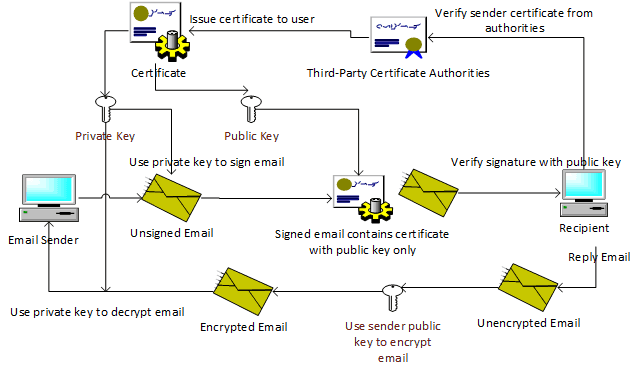Definition of Secure/Multipurpose Internet Mail Extensions (S/MIME) in Network Encyclopedia.
What is S/MIME (Secure/Multipurpose Internet Mail Extensions)?
S/MIME is a protocol for the secure exchange of e-mail and attached documents originally developed by RSA Security. Secure/Multipurpose Internet Mail Extensions (S/MIME) adds security to Internet e-mail based on the Simple Mail Transfer Protocol (SMTP) method and adds support for digital signatures and encryption to SMTP mail to support authentication of the sender and privacy of the communication. Note that because HTTP messages can transport MIME data, they can also use S/MIME.
How It Works
S/MIME is an extension of the widely implemented Multipurpose Internet Mail Extensions (MIME) encoding standard, which defines how the body portion of an SMTP message is structured and formatted. S/MIME uses the RSA public key cryptography algorithm along with the Data Encryption Standard (DES) or Rivest-Shamir-Adleman (RSA) encryption algorithm. In an S/MIME message, the MIME body section consists of a message in PKCS #7 format that contains an encrypted form of the MIME body parts. The MIME content type for the encrypted data is application/pkcs7-mime.

Understanding Digital Signatures
Digital signatures are the more commonly used service of S/MIME. As the name suggests, digital signatures are the digital counterpart to the traditional, legal signature on a paper document. As with a legal signature, digital signatures provide the following security capabilities:
- Authentication A signature serves to validate an identity. It verifies the answer to “who are you” by providing a means of differentiating that entity from all others and proving its uniqueness. Because there is no authentication in SMTP e-mail, there is no way to know who actually sent a message. Authentication in a digital signature solves this problem by allowing a recipient to know that a message was sent by the person or organization who claims to have sent the message.
- Nonrepudiation The uniqueness of a signature prevents the owner of the signature from disowning the signature. This capability is called nonrepudiation. Thus, the authentication that a signature provides gives the means to enforce nonrepudiation. The concept of nonrepudiation is most familiar in the context of paper contracts: a signed contract is a legally binding document, and it is impossible to disown an authenticated signature. Digital signatures provide the same function and, increasingly in some areas, are recognized as legally binding, similar to a signature on paper. Because SMTP e-mail does not provide a means of authentication, it cannot provide nonrepudiation. It is easy for a sender to disavow ownership of an SMTP e-mail message.
- Data integrity An additional security service that digital signatures provide is data integrity. Data integrity is a result of the specific operations that make digital signatures possible. With data integrity services, when the recipient of a digitally signed e-mail message validates the digital signature, the recipient is assured that the e-mail message that is received is, in fact, the same message that was signed and sent, and has not been altered while in transit. Any alteration of the message while in transit after it has been signed invalidates the signature. In this way, digital signatures are able to provide an assurance that signatures on paper cannot, because it is possible for a paper document to be altered after it has been signed.
To learn more: Understanding S/MIME
NOTE
S/MIME is gaining in popularity in the enterprise because its key management facilities are implemented as a hierarchical public key infrastructure (PKI) scheme. Version 2 of S/MIME has gained some support and is defined by Request for Comments (RFC) 2311 through 2315. An Internet Engineering Task Force (IETF) working group is currently working on version 3, which is expected to become an Internet standard when it is completed.